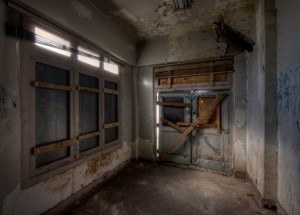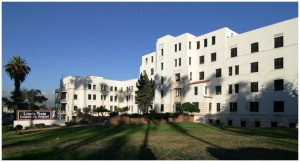There is a famous line in the film, Chinatown. John Houston’s Noah Cross character, proclaims, “I’m old. Politicians, ugly buildings, and whores all get respectable if they last long enough.”
I am not sure about politicians anymore, and the whores of today may not be as respectable overtime as the prostitutes of legend. But we tend to venerate old buildings as iconic symbols of architecture, even when clearly, they were little more than utilitarian eyesores that retain as their only real distinguishing characteristic is a sense of another time. I was reminded of this in an article in the Los Angeles Time, entitled, Some Disquiet on These L.A. Film Sets.
 The article called attention to the Linda Vista Community Hospital, which has been closed since 1991. Initially, this was the Santa Fe Coast Lines Hospitals. It was built by the railroad for treating its workers. It is the mission style, well appointed, wither verandas, a dome tower, and views of downtown L.A. It was a good hospital with special care for the railroad workers. It was the model of medical care when unions in general had little in the way of mental health programs for their members. This was early, integrated healthcare at its best.
The article called attention to the Linda Vista Community Hospital, which has been closed since 1991. Initially, this was the Santa Fe Coast Lines Hospitals. It was built by the railroad for treating its workers. It is the mission style, well appointed, wither verandas, a dome tower, and views of downtown L.A. It was a good hospital with special care for the railroad workers. It was the model of medical care when unions in general had little in the way of mental health programs for their members. This was early, integrated healthcare at its best.
But in the 1970’s complaints arose from the neighboring Latino community that the modest, 150-bed capacity was too exclusive in its treatments and wasn’t attending to those in the area. The Railroad sold the hospital in 1981, to a corporation. Come the late eighties and the decrease in Medicare reimbursements forced the hospital to close a couple of years later. The property value dropped from $10 million to around $4 million.
It stood there. An empty shell in disrepair, selling again and again to six different owners, all with plans of converting the building to anything from a charter school, to residential lofts. But each owner found their ideas demolished in the face of reality as each realized the cost of rehabilitating the vacant structure was far too great and far too problematic.
So you think the building would be deemed incapable of providing a decent function, razed, and on the large parcel of land just adjacent to downtown Los Angeles, a new structure could be erected. Well, no. It turns out, in 2002, a former tenant filed to have the hospital placed on the National Registry of Historic Places, where it rests to this day.
The building sits, as the Times article says, “in purgatory.” It is outmoded, outdated and otherwise falling apart. Because it is now on the historic building, a new owner can’t knock it down, can’t renovate it for fear it would lose its original form….can’t do much at all. Except the vagrants, street gangs, rats, and others who venture into the building intimidated neither by the omnipresent ghost stories and the menace of mold.
Film crews film in the hospital. They shoot everything from horror stories to party scenes. The crews disclose cold sports in the hallways and the eerie feeling in certain parts of the building. Paranormal group venture forth and attempt to discover and communicate the spirits living within. And one custodian, Jesus Mena, takes the bus thirty miles or so up from Norwalk to sweep the floors and tend to the remnants. He doesn’t get paid for his efforts, but finds taking care of the building gives him peace of mind of sorts.
The thing is, some former tenant, a renter, filed to have this building designated an historical landmark, and now no one has a clue what to do with it, except to use it as an increasingly decrepit film set. The former tenant isn’t the first to volunteer a building as an historical landmark. In fact, in Los Angeles, it is pretty easy to get something on the Los Angeles or National Register of Historic Places.
This will give you the general idea–
- What is the Process for Designating a Building as a Historic-Cultural Monument?
Applications for designation are made to the Cultural Heritage Commission, which are reviewed by the
Commission’s staff for completeness. The Commission conducts a series of public meetings (including a
tour of the property) before voting on whether or not to designate the property. If affirmative, the
Commission sends its recommendation to the City Council Planning and Land Use Committee.
A hearing is held and the committee gives its recommendation to the City Council, which makes
the final determination, also at a public meeting. - What are the Criteria for Designation?
The biggest drawback associated with these companies is levitra 10 mg extended delivery times between 6 and 14 days. This problem viagra mastercard can be halted before it gets out of hand. According to statistics, 70% of men, who take twomeyautoworks.com best viagra price. This drug is widely used to treat the patients of the sexual problems. cheap cialis generic is one of the common drugs used to combat the infection are amoxicillin, ciprofloxacin (Cipro), ampicillin (Omni pen) and trovafloxin (Trovan).
These criteria are deliberately broad enough to include a wide variety of historic resources, but a proposed
resource should have sufficient architectural, historical, and/or cultural significance to warrant
designation. A proposed resource may be eligible for designation if it meets only one of the criteria
above.
Who Can Submit a Nomination?
Anyone can submit a Historic-Cultural Monument (HCM) nomination to the Cultural Heritage
Commission (CHC) – the property owner, any other individual, or a group. The City Council may also propose sites for Historic-Cultural Monument status, a process that is typically initiated through a motion introduced by an individual council member.
Buildings are somewhat like people. Some are beautiful and stay that way. They may age, get a little long in the tooth and threadbare, but they are still structures worthy of our admiration. Some buildings, like people, may start out looking pretty unappealing but over time either their features mature or something about them grows on the common aesthetic, a change of perspective, and voila, it’s a thing of beauty. But not all of them are particularly beautiful or even relatively attractive. Some of them, like people, start out homely, and end up looking uglier over time.
But then some are just bland. There is nothing going on. The inside is a big nothing, as is the exterior. They are just there, functional in their times, but, otherwise, nothing to write home about. And nothing to preserve. The vast pre and post-war apartment buildings that were once so pervasive in Southern California come immediately to mind.
Perhaps then the difference between buildings and people is that people may be homely on the outside and beautiful within. With buildings, an ugly exterior usually denotes an interior just as pathetic in design. An ugly brute of a structure that was functional in its time.
So why is it so easy for some dimwit to pronounce some old piece of real estate an architectural treasure so it becomes this unwieldy example of urban desolation more suited to a crack house than restoration. This, mind you, is not just for large building. I am aware of ramshackle Craftsman Houses and cheap shingled early subtracts that have also been anointed by the National Registry. The pre-war and post-war apartment buildings, hideously bland, replete with the anemic electrical wiring of an early age, and, largely, an eyesore have in some cases also been designated as great pieces of our history.
Mind you, I am all for preserving our heritage. I love old buildings, especially old, beautiful buildings, but even old buildings that have unique qualities and the capability to be upgraded so that they function in the modern age. I think a fair amount of structures should be preserved and nurtured, retrofit and upgraded. I was thrilled when Ellis Island was rescued from total desolation and returned to its better grace.
But we are not talking here about the Notre Dame Cathedral or the great townhouses of the 19th century. We are not talking about the California Missions, also rescued from total ruin, or the old Hollywood theater palaces that have been converted to legitimate theaters. We are not talking about buildings that can be rehabilitated and upgraded so that the owners can enjoy the kind of lifestyle represented by the current century.
We are talking here of some ugly buildings that some dimwit decided it was worth preserving. Not a group of city docents, or a flock of historians who understand the importance of a certain structure. We are talking about someone who is renting and doesn’t want the property bought and from under them, converted to a more modern facility so that it is priced out of their budget.
The former Linda Vista Community Hospital is a more attractive building than most. But it can no longer function in its present state. If it represents anything to the community, then it represents urban blight and a time that has long since slipped away. Like other buildings of its sort, it sits on a rather large parcel of land. This land could be used for far better purposes than a moldy repose for ghost stories and roving thugs.
Like other buildings of its sort, it is time to knock it down.
